warning light DODGE CHALLENGER 2019 Vehicle Warranty
[x] Cancel search | Manufacturer: DODGE, Model Year: 2019, Model line: CHALLENGER, Model: DODGE CHALLENGER 2019Pages: 270, PDF Size: 2.52 MB
Page 132 of 270
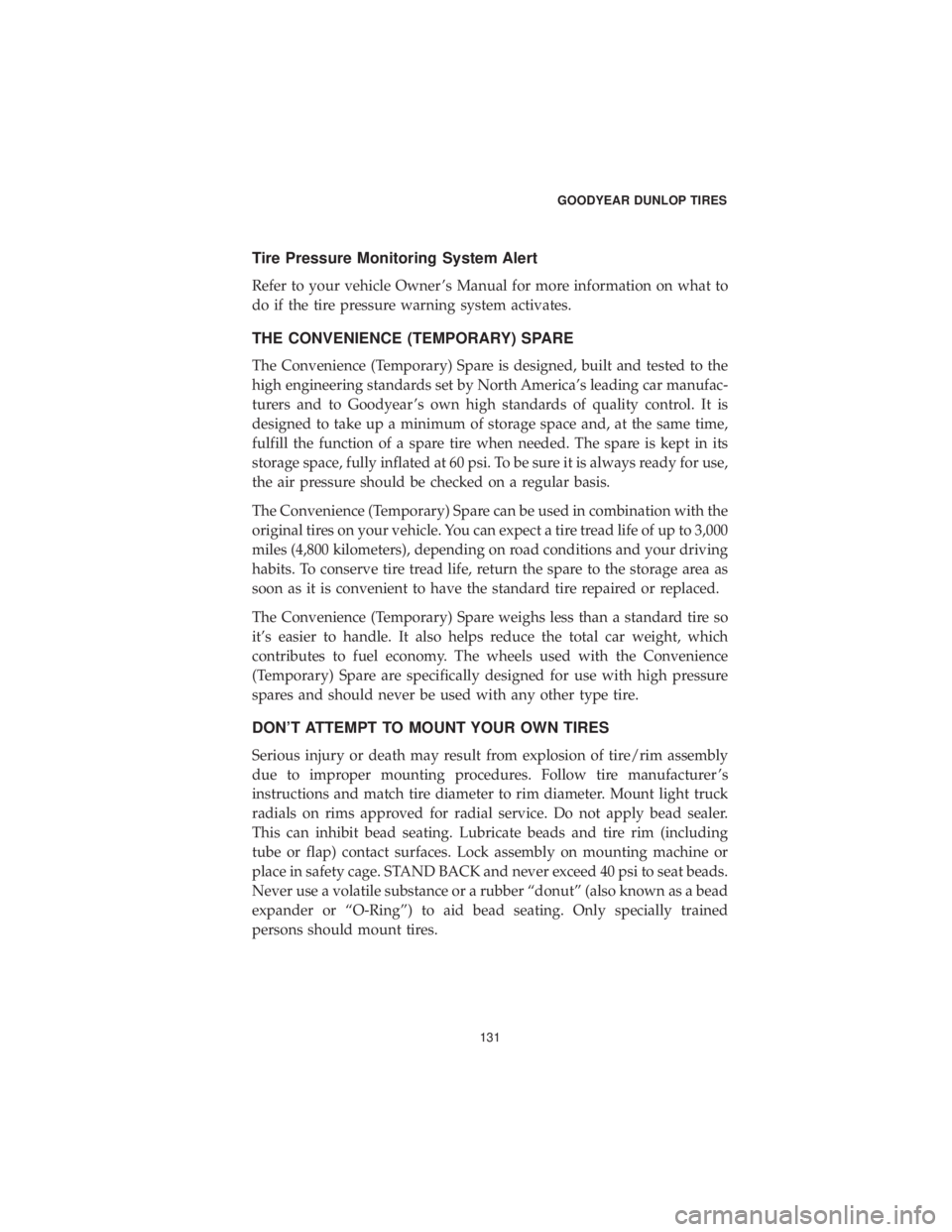
Tire Pressure Monitoring System Alert
Refer to your vehicle Owner ’s Manual for more information on what to
do if the tire pressure warning system activates.
THE CONVENIENCE (TEMPORARY) SPARE
The Convenience (Temporary) Spare is designed, built and tested to the
high engineering standards set by North America’s leading car manufac-
turers and to Goodyear ’s own high standards of quality control. It is
designed to take up a minimum of storage space and, at the same time,
fulfill the function of a spare tire when needed. The spare is kept in its
storage space, fully inflated at 60 psi. To be sure it is always ready for use,
the air pressure should be checked on a regular basis.
The Convenience (Temporary) Spare can be used in combination with the
original tires on your vehicle. You can expect a tire tread life of up to 3,000
miles (4,800 kilometers), depending on road conditions and your driving
habits. To conserve tire tread life, return the spare to the storage area as
soon as it is convenient to have the standard tire repaired or replaced.
The Convenience (Temporary) Spare weighs less than a standard tire so
it’s easier to handle. It also helps reduce the total car weight, which
contributes to fuel economy. The wheels used with the Convenience
(Temporary) Spare are specifically designed for use with high pressure
spares and should never be used with any other type tire.
DON’T ATTEMPT TO MOUNT YOUR OWN TIRES
Serious injury or death may result from explosion of tire/rim assembly
due to improper mounting procedures. Follow tire manufacturer ’s
instructions and match tire diameter to rim diameter. Mount light truck
radials on rims approved for radial service. Do not apply bead sealer.
This can inhibit bead seating. Lubricate beads and tire rim (including
tube or flap) contact surfaces. Lock assembly on mounting machine or
place in safety cage. STAND BACK and never exceed 40 psi to seat beads.
Never use a volatile substance or a rubber “donut” (also known as a bead
expander or “O-Ring”) to aid bead seating. Only specially trained
persons should mount tires.
GOODYEAR DUNLOP TIRES
131
Page 160 of 270
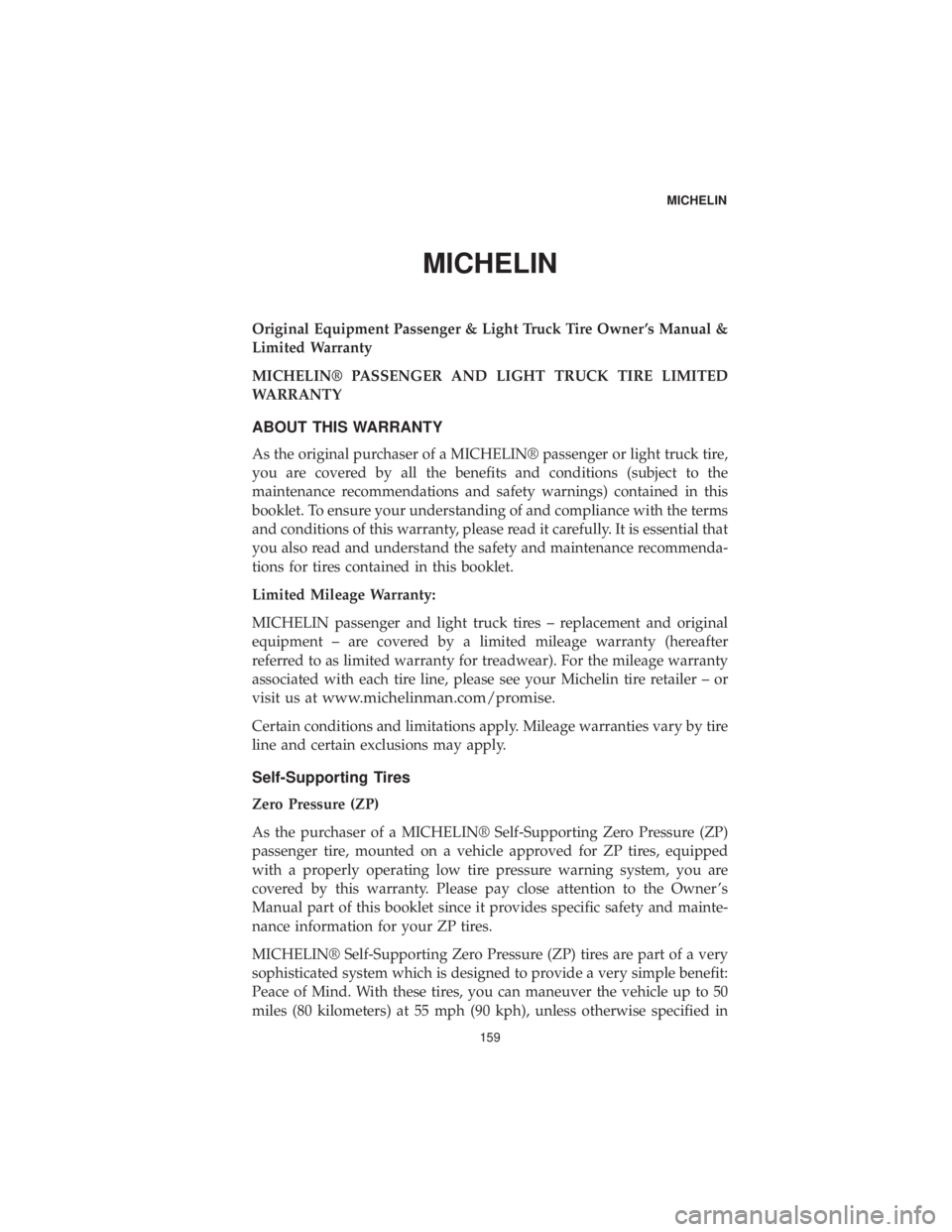
MICHELIN
Original Equipment Passenger & Light Truck Tire Owner ’s Manual &
Limited Warranty
MICHELIN® PASSENGER AND LIGHT TRUCK TIRE LIMITED
WARRANTY
ABOUT THIS WARRANTY
As the original purchaser of a MICHELIN® passenger or light truck tire,
you are covered by all the benefits and conditions (subject to the
maintenance recommendations and safety warnings) contained in this
booklet. To ensure your understanding of and compliance with the terms
and conditions of this warranty, please read it carefully. It is essential that
you also read and understand the safety and maintenance recommenda-
tions for tires contained in this booklet.
Limited Mileage Warranty:
MICHELIN passenger and light truck tires – replacement and original
equipment – are covered by a limited mileage warranty (hereafter
referred to as limited warranty for treadwear). For the mileage warranty
associated with each tire line, please see your Michelin tire retailer – or
visit us at
www.michelinman.com/promise.
Certain conditions and limitations apply. Mileage warranties vary by tire
line and certain exclusions may apply.
Self-Supporting Tires
Zero Pressure (ZP)
As the purchaser of a MICHELIN® Self-Supporting Zero Pressure (ZP)
passenger tire, mounted on a vehicle approved for ZP tires, equipped
with a properly operating low tire pressure warning system, you are
covered by this warranty. Please pay close attention to the Owner ’s
Manual part of this booklet since it provides specific safety and mainte-
nance information for your ZP tires.
MICHELIN® Self-Supporting Zero Pressure (ZP) tires are part of a very
sophisticated system which is designed to provide a very simple benefit:
Peace of Mind. With these tires, you can maneuver the vehicle up to 50
miles (80 kilometers) at 55 mph (90 kph), unless otherwise specified in
MICHELIN
159
Page 161 of 270
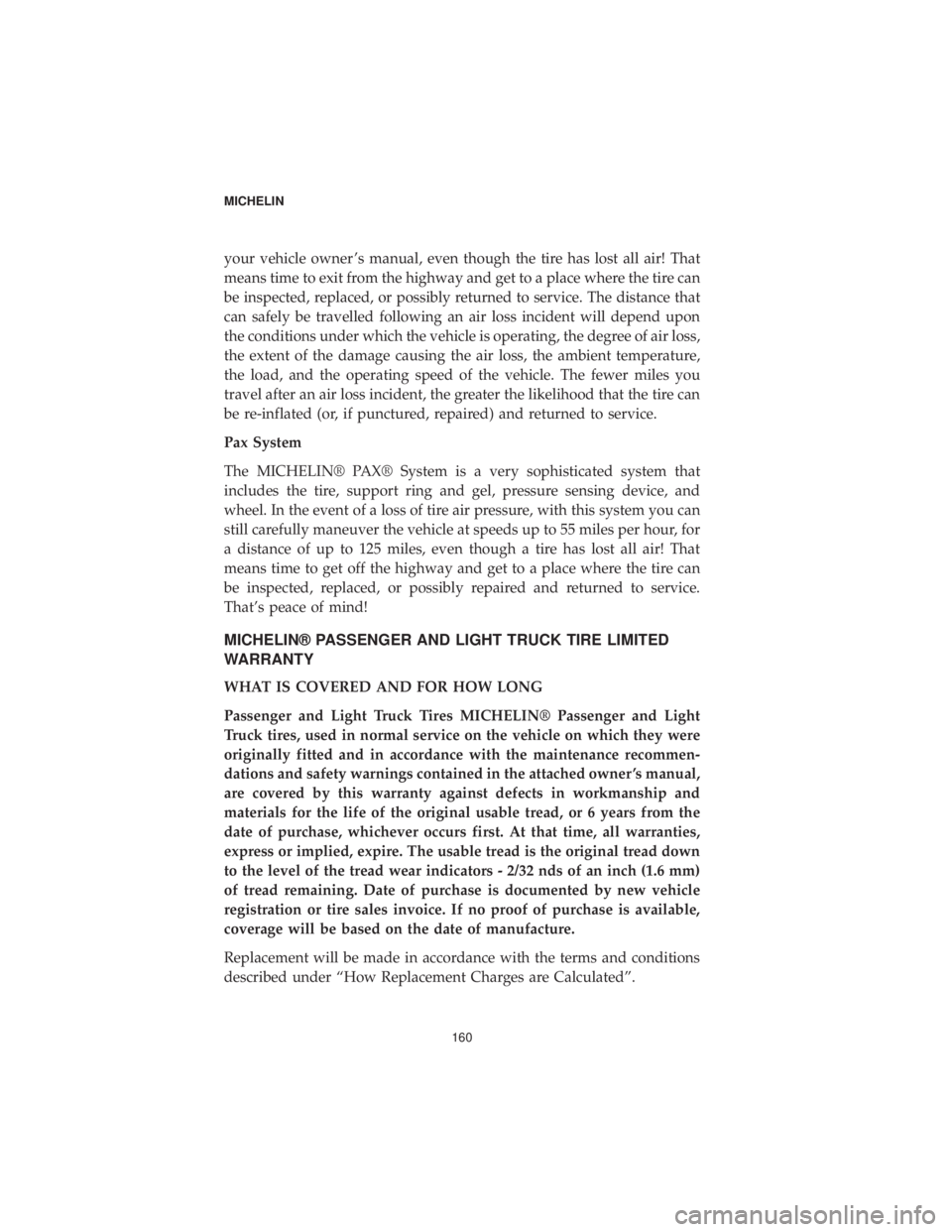
your vehicle owner ’s manual, even though the tire has lost all air! That
means time to exit from the highway and get to a place where the tire can
be inspected, replaced, or possibly returned to service. The distance that
can safely be travelled following an air loss incident will depend upon
the conditions under which the vehicle is operating, the degree of air loss,
the extent of the damage causing the air loss, the ambient temperature,
the load, and the operating speed of the vehicle. The fewer miles you
travel after an air loss incident, the greater the likelihood that the tire can
be re-inflated (or, if punctured, repaired) and returned to service.
Pax System
The MICHELIN® PAX® System is a very sophisticated system that
includes the tire, support ring and gel, pressure sensing device, and
wheel. In the event of a loss of tire air pressure, with this system you can
still carefully maneuver the vehicle at speeds up to 55 miles per hour, for
a distance of up to 125 miles, even though a tire has lost all air! That
means time to get off the highway and get to a place where the tire can
be inspected, replaced, or possibly repaired and returned to service.
That’s peace of mind!
MICHELIN® PASSENGER AND LIGHT TRUCK TIRE LIMITED
WARRANTY
WHAT IS COVERED AND FOR HOW LONG
Passenger and Light Truck Tires MICHELIN® Passenger and Light
Truck tires, used in normal service on the vehicle on which they were
originally fitted and in accordance with the maintenance recommen-
dations and safety warnings contained in the attached owner ’s manual,
are covered by this warranty against defects in workmanship and
materials for the life of the original usable tread, or 6 years from the
date of purchase, whichever occurs first. At that time, all warranties,
express or implied, expire. The usable tread is the original tread down
to the level of the tread wear indicators - 2/32 nds of an inch (1.6 mm)
of tread remaining. Date of purchase is documented by new vehicle
registration or tire sales invoice. If no proof of purchase is available,
coverage will be based on the date of manufacture.
Replacement will be made in accordance with the terms and conditions
described under “How Replacement Charges are Calculated”.
MICHELIN160
Page 235 of 270
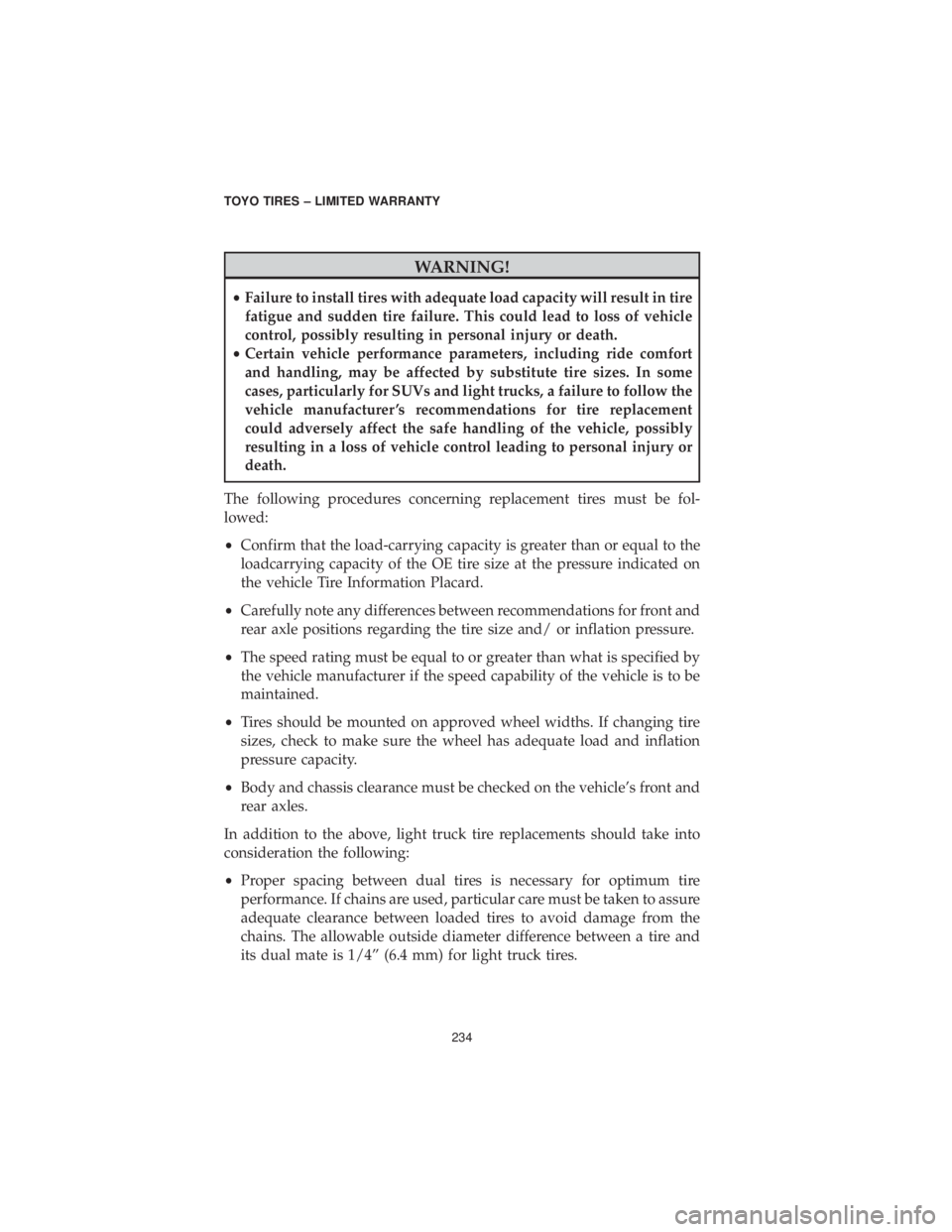
WARNING!
•Failure to install tires with adequate load capacity will result in tire
fatigue and sudden tire failure. This could lead to loss of vehicle
control, possibly resulting in personal injury or death.
• Certain vehicle performance parameters, including ride comfort
and handling, may be affected by substitute tire sizes. In some
cases, particularly for SUVs and light trucks, a failure to follow the
vehicle manufacturer ’s recommendations for tire replacement
could adversely affect the safe handling of the vehicle, possibly
resulting in a loss of vehicle control leading to personal injury or
death.
The following procedures concerning replacement tires must be fol-
lowed:
• Confirm that the load-carrying capacity is greater than or equal to the
loadcarrying capacity of the OE tire size at the pressure indicated on
the vehicle Tire Information Placard.
• Carefully note any differences between recommendations for front and
rear axle positions regarding the tire size and/ or inflation pressure.
• The speed rating must be equal to or greater than what is specified by
the vehicle manufacturer if the speed capability of the vehicle is to be
maintained.
• Tires should be mounted on approved wheel widths. If changing tire
sizes, check to make sure the wheel has adequate load and inflation
pressure capacity.
• Body and chassis clearance must be checked on the vehicle’s front and
rear axles.
In addition to the above, light truck tire replacements should take into
consideration the following:
• Proper spacing between dual tires is necessary for optimum tire
performance. If chains are used, particular care must be taken to assure
adequate clearance between loaded tires to avoid damage from the
chains. The allowable outside diameter difference between a tire and
its dual mate is 1/4” (6.4 mm) for light truck tires.
TOYO TIRES – LIMITED WARRANTY
234
Page 236 of 270
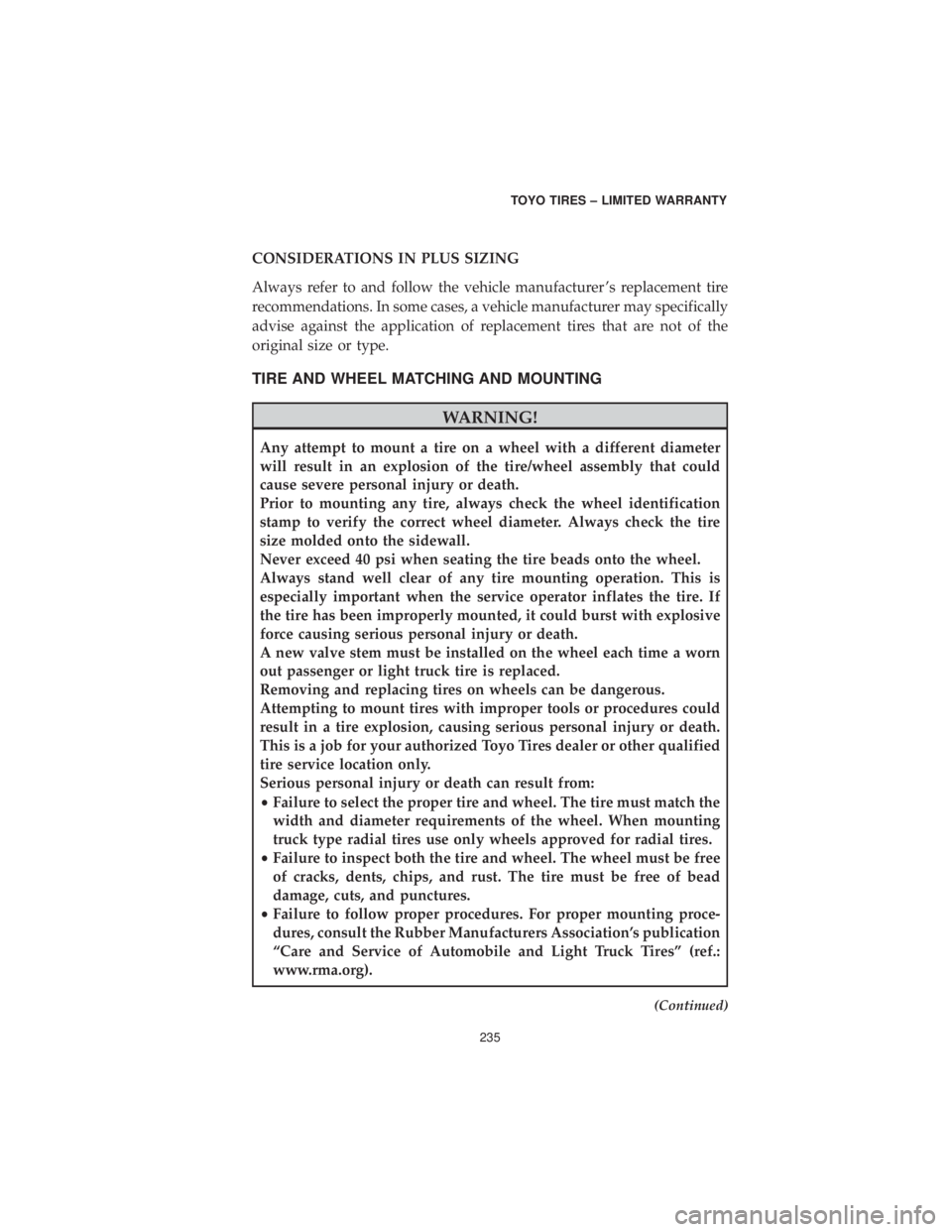
CONSIDERATIONS IN PLUS SIZING
Always refer to and follow the vehicle manufacturer ’s replacement tire
recommendations. In some cases, a vehicle manufacturer may specifically
advise against the application of replacement tires that are not of the
original size or type.
TIRE AND WHEEL MATCHING AND MOUNTING
WARNING!
Any attempt to mount a tire on a wheel with a different diameter
will result in an explosion of the tire/wheel assembly that could
cause severe personal injury or death.
Prior to mounting any tire, always check the wheel identification
stamp to verify the correct wheel diameter. Always check the tire
size molded onto the sidewall.
Never exceed 40 psi when seating the tire beads onto the wheel.
Always stand well clear of any tire mounting operation. This is
especially important when the service operator inflates the tire. If
the tire has been improperly mounted, it could burst with explosive
force causing serious personal injury or death.
A new valve stem must be installed on the wheel each time a worn
out passenger or light truck tire is replaced.
Removing and replacing tires on wheels can be dangerous.
Attempting to mount tires with improper tools or procedures could
result in a tire explosion, causing serious personal injury or death.
This is a job for your authorized Toyo Tires dealer or other qualified
tire service location only.
Serious personal injury or death can result from:
•Failure to select the proper tire and wheel. The tire must match the
width and diameter requirements of the wheel. When mounting
truck type radial tires use only wheels approved for radial tires.
• Failure to inspect both the tire and wheel. The wheel must be free
of cracks, dents, chips, and rust. The tire must be free of bead
damage, cuts, and punctures.
• Failure to follow proper procedures. For proper mounting proce-
dures, consult the Rubber Manufacturers Association’s publication
“Care and Service of Automobile and Light Truck Tires” (ref.:
www.rma.org).
(Continued)
TOYO TIRES – LIMITED WARRANTY
235
Page 238 of 270
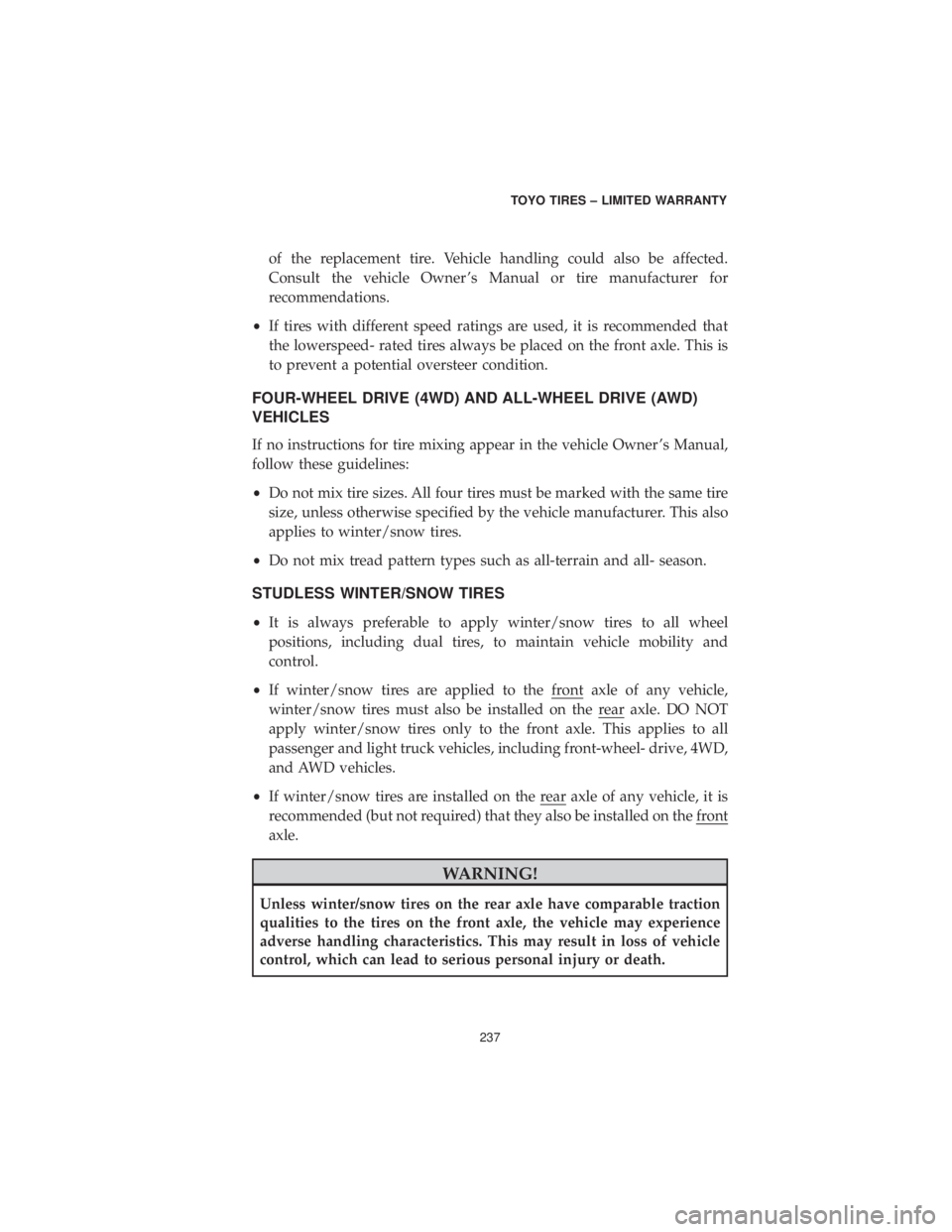
of the replacement tire. Vehicle handling could also be affected.
Consult the vehicle Owner ’s Manual or tire manufacturer for
recommendations.
• If tires with different speed ratings are used, it is recommended that
the lowerspeed- rated tires always be placed on the front axle. This is
to prevent a potential oversteer condition.
FOUR-WHEEL DRIVE (4WD) AND ALL-WHEEL DRIVE (AWD)
VEHICLES
If no instructions for tire mixing appear in the vehicle Owner ’s Manual,
follow these guidelines:
• Do not mix tire sizes. All four tires must be marked with the same tire
size, unless otherwise specified by the vehicle manufacturer. This also
applies to winter/snow tires.
• Do not mix tread pattern types such as all-terrain and all- season.
STUDLESS WINTER/SNOW TIRES
•It is always preferable to apply winter/snow tires to all wheel
positions, including dual tires, to maintain vehicle mobility and
control.
• If winter/snow tires are applied to the front axle of any vehicle,
winter/snow tires must also be installed on the rear axle. DO NOT
apply winter/snow tires only to the front axle. This applies to all
passenger and light truck vehicles, including front-wheel- drive, 4WD,
and AWD vehicles.
• If winter/snow tires are installed on the rear axle of any vehicle, it is
recommended (but not required) that they also be installed on the front
axle.
WARNING!
Unless winter/snow tires on the rear axle have comparable traction
qualities to the tires on the front axle, the vehicle may experience
adverse handling characteristics. This may result in loss of vehicle
control, which can lead to serious personal injury or death.
TOYO TIRES – LIMITED WARRANTY
237
Page 242 of 270
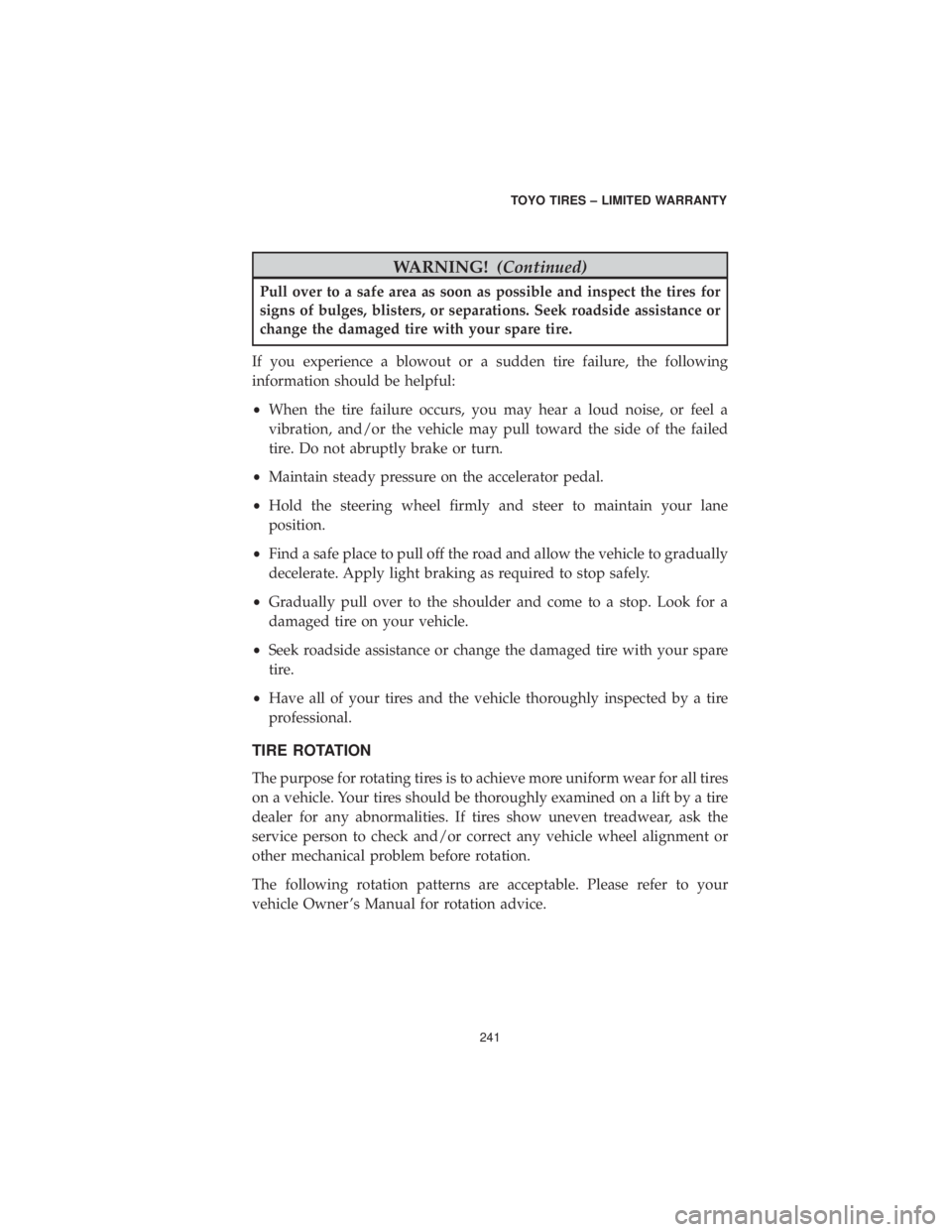
WARNING!(Continued)
Pull over to a safe area as soon as possible and inspect the tires for
signs of bulges, blisters, or separations. Seek roadside assistance or
change the damaged tire with your spare tire.
If you experience a blowout or a sudden tire failure, the following
information should be helpful:
• When the tire failure occurs, you may hear a loud noise, or feel a
vibration, and/or the vehicle may pull toward the side of the failed
tire. Do not abruptly brake or turn.
• Maintain steady pressure on the accelerator pedal.
• Hold the steering wheel firmly and steer to maintain your lane
position.
• Find a safe place to pull off the road and allow the vehicle to gradually
decelerate. Apply light braking as required to stop safely.
• Gradually pull over to the shoulder and come to a stop. Look for a
damaged tire on your vehicle.
• Seek roadside assistance or change the damaged tire with your spare
tire.
• Have all of your tires and the vehicle thoroughly inspected by a tire
professional.
TIRE ROTATION
The purpose for rotating tires is to achieve more uniform wear for all tires
on a vehicle. Your tires should be thoroughly examined on a lift by a tire
dealer for any abnormalities. If tires show uneven treadwear, ask the
service person to check and/or correct any vehicle wheel alignment or
other mechanical problem before rotation.
The following rotation patterns are acceptable. Please refer to your
vehicle Owner ’s Manual for rotation advice.
TOYO TIRES – LIMITED WARRANTY
241
Page 245 of 270
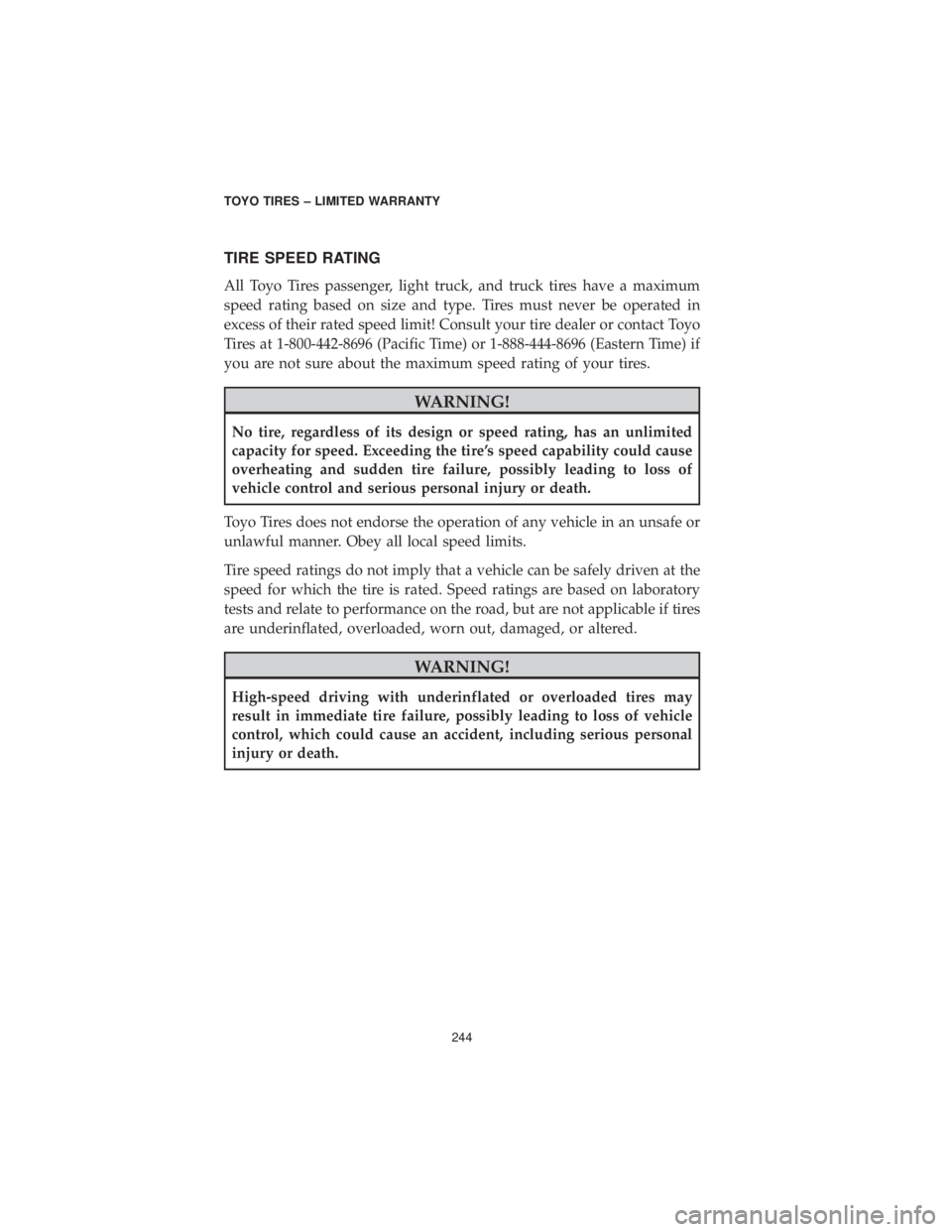
TIRE SPEED RATING
All Toyo Tires passenger, light truck, and truck tires have a maximum
speed rating based on size and type. Tires must never be operated in
excess of their rated speed limit! Consult your tire dealer or contact Toyo
Tires at 1-800-442-8696 (Pacific Time) or 1-888-444-8696 (Eastern Time) if
you are not sure about the maximum speed rating of your tires.
WARNING!
No tire, regardless of its design or speed rating, has an unlimited
capacity for speed. Exceeding the tire’s speed capability could cause
overheating and sudden tire failure, possibly leading to loss of
vehicle control and serious personal injury or death.
Toyo Tires does not endorse the operation of any vehicle in an unsafe or
unlawful manner. Obey all local speed limits.
Tire speed ratings do not imply that a vehicle can be safely driven at the
speed for which the tire is rated. Speed ratings are based on laboratory
tests and relate to performance on the road, but are not applicable if tires
are underinflated, overloaded, worn out, damaged, or altered.
WARNING!
High-speed driving with underinflated or overloaded tires may
result in immediate tire failure, possibly leading to loss of vehicle
control, which could cause an accident, including serious personal
injury or death.
TOYO TIRES – LIMITED WARRANTY
244
Page 252 of 270
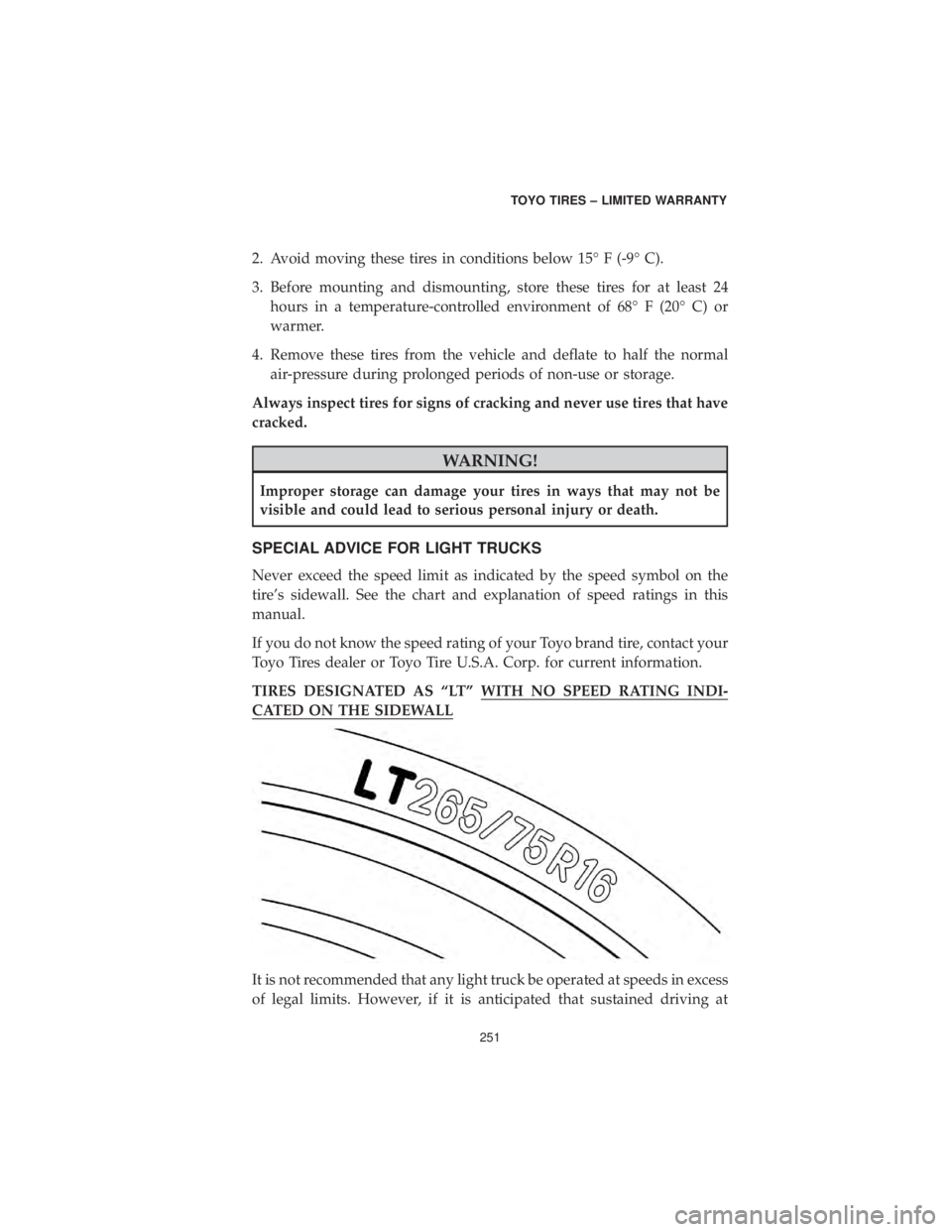
2. Avoid moving these tires in conditions below 15° F (-9° C).
3. Before mounting and dismounting, store these tires for at least 24hours in a temperature-controlled environment of 68° F (20° C) or
warmer.
4. Remove these tires from the vehicle and deflate to half the normal air-pressure during prolonged periods of non-use or storage.
Always inspect tires for signs of cracking and never use tires that have
cracked.
WARNING!
Improper storage can damage your tires in ways that may not be
visible and could lead to serious personal injury or death.
SPECIAL ADVICE FOR LIGHT TRUCKS
Never exceed the speed limit as indicated by the speed symbol on the
tire’s sidewall. See the chart and explanation of speed ratings in this
manual.
If you do not know the speed rating of your Toyo brand tire, contact your
Toyo Tires dealer or Toyo Tire U.S.A. Corp. for current information.
TIRES DESIGNATED AS “LT” WITH NO SPEED RATING INDI-
CATED ON THE SIDEWALL
It is not recommended that any light truck be operated at speeds in excess
of legal limits. However, if it is anticipated that sustained driving at
TOYO TIRES – LIMITED WARRANTY
251
Page 253 of 270
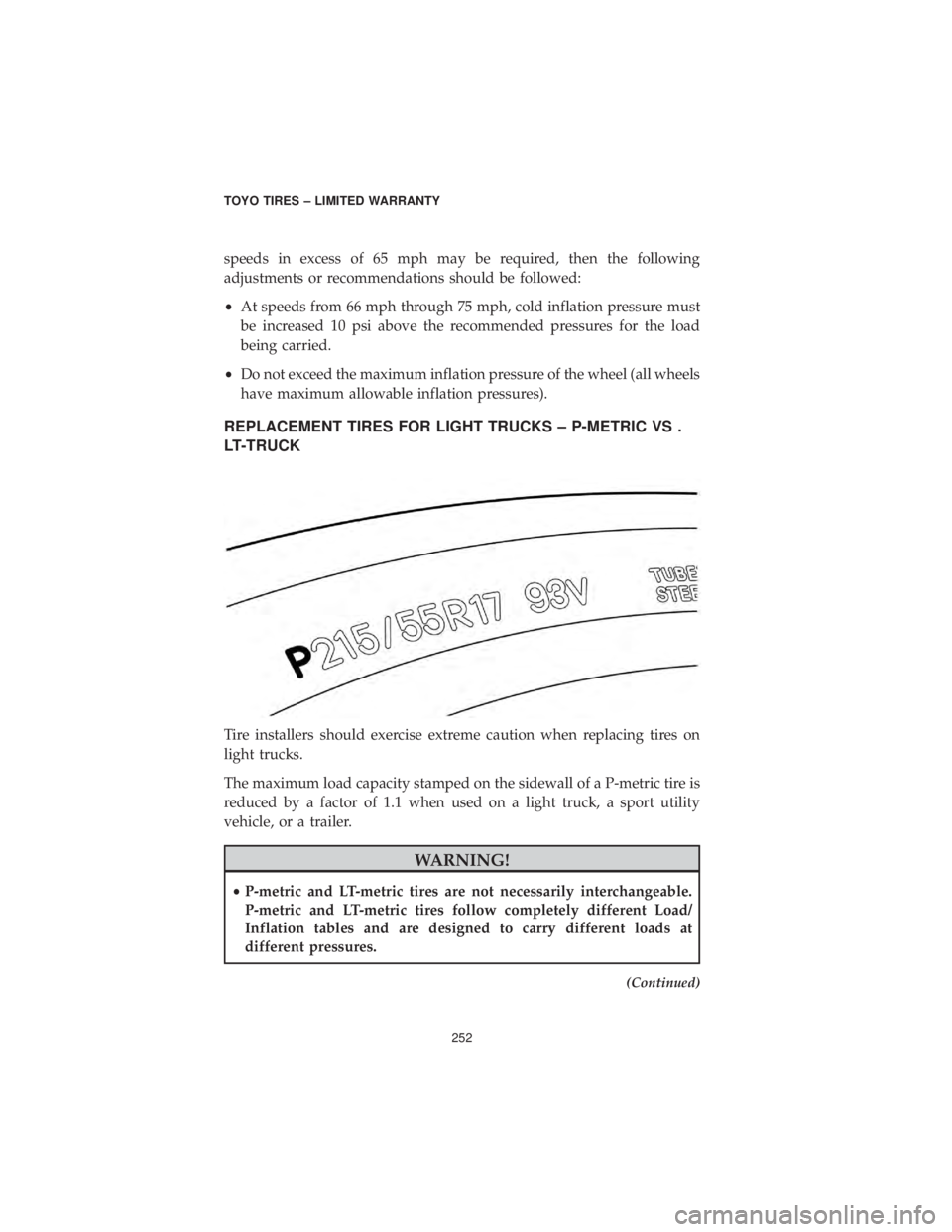
speeds in excess of 65 mph may be required, then the following
adjustments or recommendations should be followed:
•At speeds from 66 mph through 75 mph, cold inflation pressure must
be increased 10 psi above the recommended pressures for the load
being carried.
• Do not exceed the maximum inflation pressure of the wheel (all wheels
have maximum allowable inflation pressures).
REPLACEMENT TIRES FOR LIGHT TRUCKS – P-METRIC VS .
LT-TRUCK
Tire installers should exercise extreme caution when replacing tires on
light trucks.
The maximum load capacity stamped on the sidewall of a P-metric tire is
reduced by a factor of 1.1 when used on a light truck, a sport utility
vehicle, or a trailer.
WARNING!
• P-metric and LT-metric tires are not necessarily interchangeable.
P-metric and LT-metric tires follow completely different Load/
Inflation tables and are designed to carry different loads at
different pressures.
(Continued)
TOYO TIRES – LIMITED WARRANTY
252